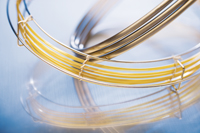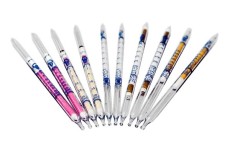
Chromatography
Rtx-1 F&F
(Crossbond® 100% dimethyl polysiloxane)
- Application-specific columns for flavor and fragrance compounds.
Retention index libraries in the flavor and fragrance industry have been compiled from years of data and thousands of compounds. Any slight variation in column selectivity could render the column useless. Rtx®-1 F&F columns are tailored to match the selectivity required in the industry, while offering excellent thermal stability. Our stringent quality testing ensures column-to-column reproducibility and extended column lifetimes over conventional 100% dimethyl polysiloxane columns.
Applications
- Flavor and fragrance compounds
| ID (mm) | df(µm) | Temperature limits (°C) |
|---|---|---|
| 0.25 | 0.25 | -60 to 330/350 |
| 0.25 | 0.50 | -60 to 330/350 |
| 0.25 | 1.00 | -60 to 320/340 |
| 0.32 | 0.25 | -60 to 330/350 |
| 0.32 | 0.50 | -60 to 330/350 |
| 0.32 | 1.00 | -60 to 320/340 |
| 0.53 | 0.50 | -60 to 310/330 |
| 0.53 | 1.00 | -60 to 310/330 |
| 0.53 | 1.50 | -60 to 310/330 |
Rtx-65TG
(Crossbond® 65% diphenyl/35% dimethyl polysiloxane)
- Application-specific columns, specially tested for triglycerides.
The Rtx®-65TG phase resolves triglycerides by degree of unsaturation as well as by carbon number. Because of the chemistry required to achieve 370°C thermal stability, an Rtx®-65TG column should not be used for analyses of polar compounds.
Applications
- Triglycerides
| ID (mm) | df(µm) | Temperature limits (°C) |
|---|---|---|
| 0.25 | 0.10 | -60 to 370 |
| 0.32 | 0.10 | -60 to 370 |
| 0.53 | 0.10 | -60 to 360/370 |
Rtx-VMS
(proprietary Crossbond® phase )
- Application-specific columns for volatile organic pollutants by GC/MS.
- Complete separation of US EPA Method 8260 compounds in less than 18 minutes.
- Restek Exclusive.
Rtx®-VMS columns offer lower bleed, better selectivity, and overall faster analysis for separating volatile organic compounds, such as those listed in US EPA Method 8260. The Rtx®-VMS stationary phase is a highly stable polymer that provides outstanding analysis of volatile compounds, in combination with sensitive ion traps and mass spectrometers. 0.18 and 0.25 mm ID columns allow sample splitting at the injection port, eliminating the added expense and maintenance of a jet separator. A 0.45 mm or 0.53 mm ID column can be directly connected to the purge & trap transfer line in a system equipped with a jet separator.
Applications
- Volatile organic pollutants
| ID (mm) | df(µm) | Temperature limits (°C) |
|---|---|---|
| 0.18 | 1.00 | -40 to 240/260 |
| 0.25 | 1.40 | -40 to 240/260 |
| 0.32 | 1.50 | -40 to 240/260 |
| 0.45 | 2.55 | -40 to 240/260 |
| 0.53 | 3.00 | -40 to 240/260 |
Rt-2560
(Biscyanopropyl polysiloxane - non bonded)
- Highly polar phase.
- Aplication Specific Phase for cis/trans FAMEs.
Because the Rt™-2560 phase is not nonded, It should not be solvent rised.
Applications
- cis/trans FAMEs
| ID (mm) | df(µm) | Temperature limits (°C) |
|---|---|---|
| 0.25 | 0.20 | 20 to 250 |
Rt-2330
(90% biscyanopropyl/10% phenylcyanopropyl polysiloxane - not bonded)
- Highly polar phase.
- Equivalent to USP G48 phase.
Rt™-2330 is one of the most polar capillary column stationary phases. Cyano groups on both sides of the polymer backbone give the phase a strong dipole moment and high selectivity for cis/trans compounds or compounds with conjugated double bonds. Highly polar columns typically exhibit poor column efficiencies, high bleed, and short column lifetimes when thermally cycled. To overcome some of these problems, Restek developed a surface treatment that is more compatible with the Rt™-2330 phase. In addition, improved polymer produces columns with improved column efficiency and lower bleed. Because the Rt™-2330 stationary phase is not bonded, it should not be solvent rinsed.
Applications
- cis/trans FAMEs
- Dioxin isomers
| ID (mm) | df(µm) | Temperature limits (°C) |
|---|---|---|
| 0.25 | 0.10 | 0 to 260/275 |
| 0.25 | 0.20 | 0 to 260/275 |
| 0.32 | 0.10 | 0 to 260/275 |
| 0.32 | 0.20 | 0 to 260/275 |
| 0.53 | 0.10 | 0 to 260/275 |
| 0.53 | 0.20 | 0 to 260/275 |
Stabilwax-DB
(Crossbond® Carbowax® polyethylene glycol for amines and basic compounds)
- Application-specific columns for underivatized amines and other basic compounds.
- No need for column priming.
Stabilwax®-DB columns reduce adsorption and improve responses for many basic compounds, without analyte derivatization or column priming. For different selectivity of basic compounds, or higher oven temperatures, use an Rtx®-5 Amine or Rtx®-35 Amine column.Stabilwax®-DB is a bonded stationary phase, but avoid rinsing these columns with water or alcohols.
Applications
- Alkylamines
- Diamines
- Triamines
- Nitrogen-containing heterocyclics
| ID (mm) | df(µm) | Temperature limits (°C) |
|---|---|---|
| 0.25 | 0.25 | 40 to 210/220 |
| 0.25 | 0.50 | 40 to 210/220 |
| 0.32 | 0.25 | 40 to 210/220 |
| 0.32 | 0.50 | 40 to 210/220 |
| 0.32 | 1.00 | 40 to 210/220 |
| 0.53 | 0.50 | 40 to 210/220 |
| 0.53 | 1.00 | 40 to 210/220 |
| 0.53 | 1.50 | 40 to 210/220 |
Stabilwax
(Crossbond® Carbowax® polyethylene glycol)
- Polar phase.
- Resistant to oxidative damage.
- Equivalent to USP G14, G15, G16, G20, and G39 phases.
Our polar-deactivated surface tightly binds the Carbowax® polymer and increases thermal stability, relative to competitive columns. The bonding mechanisms produce a column that can be rejuvenated by solvent washing. Compared to silicone stationary phases, PEG phases are more resistant to damage from strongly acidic or basic volatile compounds.
Applications
- FAMEs
- Flavor compounds
- Essential oils
- Solvents
- Xylene isomers
- US EPA Method 603 (acrolein/acrylonitrile)
| ID (mm) | df(µm) | Temperature limits (°C) |
|---|---|---|
| 0.25 | 0.10 | 40 to 250 |
| 0.25 | 0.25 | 40 to 250 |
| 0.25 | 0.50 | 40 to 250 |
| 0.32 | 0.10 | 40 to 250 |
| 0.32 | 0.25 | 40 to 250 |
| 0.32 | 0.50 | 40 to 250 |
| 0.32 | 1.00 | 40 to 240/250 |
| 0.53 | 0.10 | 40 to 250 |
| 0.53 | 0.25 | 40 to 250 |
| 0.53 | 0.50 | 40 to 250 |
| 0.53 | 1.00 | 40 to 240/250 |
| 0.53 | 1.50 | 40 to 230/240 |
| 0.53 | 2.00 | 40 to 220/230 |
Rtx-Wax
(Crossbond® Carbowax® polyethylene glycol)
- Polar phase.
- Equivalent to USP G14, G15, G16, G20, and G39 phases.
Rtx®-Wax columns are the most inert and efficient PEG columns currently available. The extended operating temperature range allows analysis of compounds having a wide volatility range, and ensures low bleed at temperatures as high as 250°C. Selectivity is comparable to other Carbowax® columns, for compounds of intermediate to high polarity. Selectivity data available on request.
Applications
- FAMEs
- Solvents
- BTEX aromatics
- Flavour compounds
- Alcohols
| ID (mm) | df(µm) | Temperature limits (°C) |
|---|---|---|
| 0.10 | 0.10 | 20 to 250 |
| 0.10 | 0.20 | 20 to 240/250 |
| 0.25 | 0.10 | 20 to 250 |
| 0.25 | 0.25 | 20 to 250 |
| 0.25 | 0.50 | 20 to 250 |
| 0.32 | 0.10 | 20 to 250 |
| 0.32 | 0.25 | 20 to 250 |
| 0.32 | 0.50 | 20 to 250 |
| 0.32 | 1.00 | 20 to 240/250 |
| 0.53 | 0.25 | 20 to 250 |
| 0.53 | 0.50 | 20 to 250 |
| 0.53 | 1.00 | 20 to 240/250 |
Rtx-200 MS
(Crossbond® trifluoropropylmethyl polysiloxane)
- Midpolarity phase.
- Column specifically tested for low bleed performance.
- Equivalent to USP G6 phase.
Rtx®-200 columns have accomplished many difficult separations not possible on any other bonded stationary phase. Many analysts consider these the best, most inert midpolarity columns available. The trifluoropropyl stationary phase has a unique selectivity that changes elution orders and resolves compounds that phenyl, cyano, or Carbowax® phases can not. The Rtx®-200 column offers exceptional thermal stability, low bleed, and superior inertness--even for active compounds such as phenols, and with sensitive detectors such as ECDs, NPDs, and MSDs.
Applications
- Solvents
- Freon® fluorocarbons
- Alcohols
- Ketones
- Silanes
- Glycols
- Excellent confirmation column, with an Rtx®-5 column, for phenols, nitrosamines, organochlorine pesticides, chlorinated hydrocarbons, and chlorophenoxy herbicides.
| ID (mm) | df(µm) | Temperature limits (°C) |
|---|---|---|
| 0.25 | 0.10 | -20 to 320/340 |
| 0.25 | 0.25 | -20 to 320/340 |
| 0.25 | 0.50 | -20 to 310/330 |
| 0.25 | 1.00 | -20 to 310/330 |
| 0.32 | 0.10 | -20 to 320/340 |
| 0.32 | 0.25 | -20 to 320/340 |
| 0.32 | 0.50 | -20 to 310/330 |
| 0.32 | 1.00 | -20 to 290/310 |
| 0.53 | 0.50 | -20 to 300/320 |
| 0.53 | 1.00 | -20 to 290/310 |
| 0.53 | 1.50 | -20 to 280/300 |
Rtx-200
(Crossbond® trifluoropropylmethyl polysiloxane)
- Midpolarity phase.
- Equivalent to USP G6 phase.
Rtx®-200 columns have accomplished many difficult separations not possible on any other bonded stationary phase. Many analysts consider these the best, most inert midpolarity columns available. The trifluoropropyl stationary phase has a unique selectivity that changes elution orders and resolves compounds that phenyl, cyano, or Carbowax® phases can not. The Rtx®-200 column offers exceptional thermal stability, low bleed, and superior inertness - even for active compounds such as phenols, and with sensitive detectors such as ECDs, NPDs, and MSDs.
Applications
- Solvents
- Freon® fluorocarbons
- Alcohols
- Ketones
- Silanes
- Glycols
- Excellent confirmation column, with an Rtx®-5 column, for phenols, nitrosamines, organochlorine pesticides, chlorinated hydrocarbons, and chlorophenoxy herbicides.
| ID (mm) | df(µm) | Temperature limits (°C) |
|---|---|---|
| 0.18 | 0.20 | -20 to 310/330 |
| 0.18 | 0.40 | -20 to 310/330 |
| 0.25 | 0.10 | -20 to 320/340 |
| 0.25 | 0.25 | -20 to 320/340 |
| 0.25 | 0.50 | -20 to 310/330 |
| 0.25 | 1.00 | -20 to 310/330 |
| 0.32 | 0.10 | -20 to 320/340 |
| 0.32 | 0.25 | -20 to 320/340 |
| 0.32 | 0.50 | -20 to 310/330 |
| 0.32 | 1.00 | -20 to 290/310 |
| 0.32 | 1.50 | -20 to 280/300 |
| 0.53 | 0.10 | -20 to 310/330 |
| 0.53 | 0.25 | -20 to 310/330 |
| 0.53 | 0.50 | -20 to 300/320 |
| 0.53 | 1.00 | -20 to 290/310 |
| 0.53 | 1.50 | -20 to 280/300 |
| 0.53 | 3.00 | -20 to 260/280 |





 0
0
 0
0